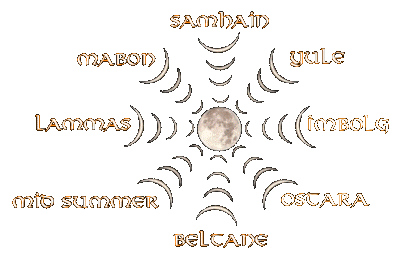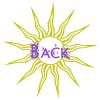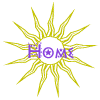

Samhain is the beginning of
the God's rule. The Goddess
is still dominant as the Crone.
This is the beginning of winter
and the Witches' New Year.
At Samhain, we celebrate the
passed year and honor those
who have passed on. This is a time
of power, when the veil between
the worlds is at its thinnest.
It is a time for divination,
goal-setting and reflection.
Practices at Samhain include:
bobbing for apples, tarot reading
and scrying, leaving food for departed
souls, setting an extra place at
the table for those passed.
Decorations include: jack-o-lanterns,
apples,autumn leaves and flowers.
The colors for Samhain are black
and orange; incenses include
nutmeg,apple and mint.
Foods for this Sabbat include
apples, nuts, cider, pumpkin
dishes, cranberries and herbal tea.
Winter Solstice. This Sabbat celebrates
the rebirth of the Sun (the God).
It is the longest night of the year
and a time to celebrate the
coming light. Practices for Yule include
lighting the Yule log (keeping a
piece for protection throughout
the year and to light the next year's
log), decorating the Yule tree
(with fruit, bells, strings of
beads and popcorn),lighting
candles to welcome the light,
and feasting. Decorate with pine cones
and evergreens. The colors for
Yule are red and green; incenses
include pine, bayberry and juniper.
Foods for Yule include
nuts, apples, wine and turkey.
Also known as Candlemas
and Brigid's Day. Imbolc celebrates
the passing of winter and
the coming of spring.
It is a time to honor the
rebirth of the sun and
celebrates the Celtic goddess Brigid.
It is a time of new
beginnings and inspiration.
Imbolc is a traditional time
for initiations. A common practice for
Imbolc is the lighting of many lamps
or candles. The colors
for Imbolc are red and yellow.
Decorations include the besom (broom),
and yellow flowers. Incenses include
cinnamon,frankincense, and wisteria.
Foods for Imbolc include all dairy
products and spiced wines.
Spring Equinox. This is the Pagan
"Easter", or more accurately, the
time the Christians chose for
their Easter.
This Sabbat celebrates the arrival of
spring. It is a day of balance -
no longer winter, but not quite spring.
At this time we celebrate the return
of the earth's fertility. Common
practices at Ostara include painting eggs
and gathering flowers. Decorations
include painted eggs and spring
flowers. The colors for
Ostara are green and yellow.
Incenses include jasmine,
rose and strawberry. Foods eaten
at this Sabbat include seeds,
fruits and boiled eggs.
Beltane is the celebration of
the union of the God and
the Goddess; a time to celebrate
new life. It is a traditional
time for handfastings,
and is a time of fertility.
Common practices for Beltane are
braiding one's hair to
symbolize the union of the Lord
and Lady, dancing around the Maypole,
and jumping the Beltane fire for good
luck. The colors of Beltane are pink,
blue and yellow. Incenses
include lilac and rose. Decorations
include the Maypole, strings
of beads and flowers and brightly
colored ribbons. Foods eaten
at this Sabbat include
cherries, strawberries and punch.
Summer Solstice; also known as
Litha. This Sabbat is a celebration
of abundance. The days now begin
to get shorter, and the
sun is at its peak. It is a good
time to make contact with faeries
and other spirit beings,and a
good time for healing magick.
Decorations include seashells,
potpourri, and summer flowers. The
colors for Midsummer are blue
and green. Incenses include
rose and lavender. Foods eaten at
this Sabbat include ale, mead,
seeds and fresh fruits and vegetables.
This is the festival of the Celtic
god Lugh. It was traditionally a time
to celebrate the harvest,
but today we celebrate the harvest of
the fruits of knowledge. It is
a time for learning and for teaching.
It is also a time to thank
the earth for its bounty. The colors for
Lughnasadh are yellow, green
and brown. Decorations include grains
and corn dolls. Incenses include
sandalwood and rose. Foods
eaten at this Sabbat
include bread, cider and berries.
Fall Equinox. A time for
thanksgiving. At Mabon, night
and day are of equal length.
This is a time of reflection
and a good time to visit the graves
of loved ones. Colors for Mabon
are yellow, brown and dark red.
Decorations include acorns, pine cones
and fallen leaves. Incenses include
myrrh, pine and sage. Foods eaten
at Mabon include corn and
cornbread, squash,
root vegetables and cider.
 |  |